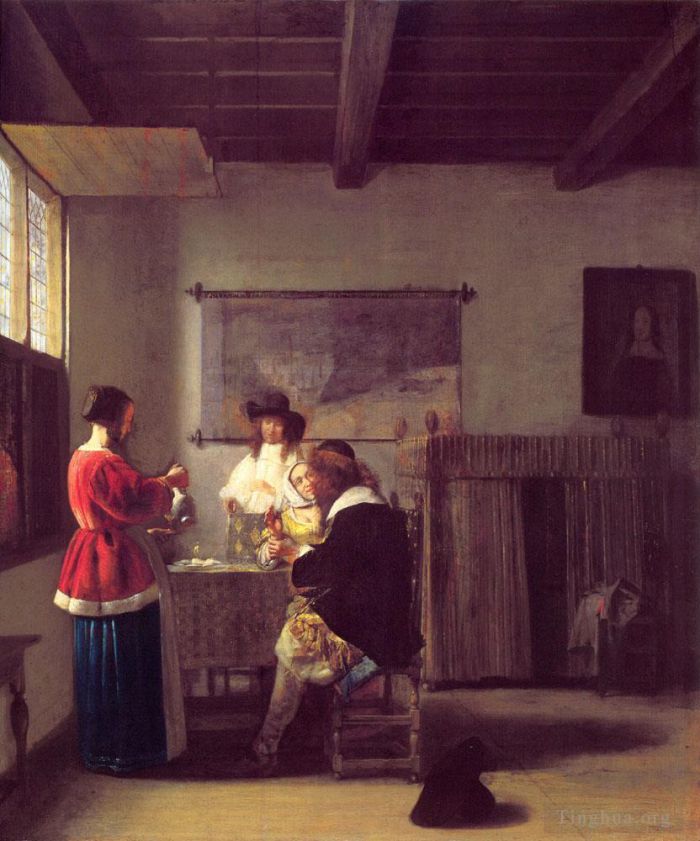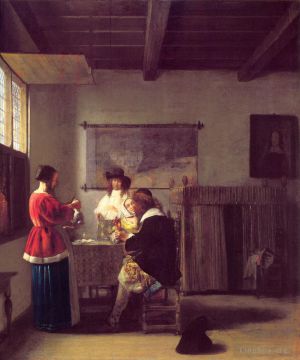The Visit
Pieter de Hooch
- Price:
- Art Type: Oil Painting
- Size:
- English Comments: 0
- International Comments: 0
- Creating Date:
- Introduction and Works of Pieter de Hooch >>
Keywords:
Visit
Work Overview
- The Visit (Merry company with two men and two women)
Artist Pieter de Hooch
Year 1657
Dimensions 26 3/4 x 23 in. (67.9 x 58.4 cm)
Location Metropolitan Museum of Art, New York city
Two women of uncertain reputation entertain visiting gentlemen. While rich in shadowy effects, this picture is one of the first in which De Hooch employed linear perspective to construct a realistic interior space (the bed, however, is underscaled). At the time, he was exchanging ideas with Vermeer, whose influence is evident in the most luminous passages. The French art critic Thoré-Bürger assigned this panel to Vermeer in his pioneering articles of the 1860s.
Merry company with two men and two women (1657) is an oil on panel painting by the Dutch painter Pieter de Hooch; it is an example of a Merry Company, a popular form of genre painting in Dutch Golden Age painting, showing a group of figures who are not meant to be identified as portraits enjoying each other's company. It is now in the Metropolitan Museum of Art, New York.
This painting by Hooch was documented by Hofstede de Groot in 1910, who wrote; "192. TWO LADIES AND TWO GENTLEMEN IN AN INTERIOR. Sm. 34. The party are assembled in the left-hand corner of a room, beside a large window, the upper part of which is fastened back. At the left corner of the table stands a girl, pouring out wine ; she wears a red jacket trimmed with white fur, a blue skirt, and a large white apron. A young gentleman, wearing a white costume, with a broad collar and a slouch hat, stands behind the table looking at the girl ; he leans with his right hand on a chair-back, and holds a pipe in his left. To the right of the table sits a gentleman in a black cape with long curls which conceal his profile ; he takes the arm of a girl, who sits beside him and regards him with a watchful and mischievous look. In the right foreground lies his slouch hat. In the background to the right is a bed with curtains ; above it hangs a portrait of a man, on the left of which is a map of a Dutch harbour with an inscription. The light falls from the left. It is a good picture, powerful and luminous in the rendering of light and colour. Burger regarded it as a Vermeer ; see Gazette des Beaux Arts for 1866, p. 551, No. 14. Panel, 27 inches by 22 1/2 inches.
In the collection of Baron Delessert, 1833 (Sm.). Sales. Francois Delessert, Paris, May 15, 1869, No. 36 (150,000 francs). B. Narischkine, Paris, April 5, 1883 (160,000 francs). Secrétan, Paris, July 1, 1889 (270,000 francs). Afterwards in the possession of Durand-Ruel of Paris. Now in the Havemeyer collection in New York."
- Copyright Statement:
All the reproduction of any forms about this work unauthorized by Singing Palette including images, texts and so on will be deemed to be violating the Copyright Laws.
To cite this webpage, please link back here.
- >> English Comments
- >> Chinese Comments
- >> French Comments
- >> German Comments
- >>Report
- Young Woman Drinking
- Woman with a Child in a Pantry
- Woman Reading a Letter
- Woman Peeling Apples
- A Mistress and her Maid
- A Woman and her Maid in a Courtyard
- Figures in a Courtyard behind a House
- Two Soldiers and a Serving Woman with a Trumpeter
- The Visit
- The Morning of a Young man
- The Courtyard of a House in Delft
- The Card Players
- The Bedroom
- Suckling Mother and Maid
- Soldiers Playing Cards
- Ruisdael Jacob Issaksz Van Winter Landscape
- Portrait of a Family in a Courtyard in Delft
- Paying the Hostess
- Musical Party in a Courtyard
- Mother Lacing Her Bodice beside a Cradle
- A Mother’s Duty (Interior with A Mother Delousing her Child’s Hair)
- Figures Drinking in a Courtyard
- De Mother
- Couple with Parrot
- Company Making Music
- Card Players in a Sunlit Room
- Interior with Women beside a Linen Cupboard (At the Linen Closet or Two Women Beside a Linen Chest with a Child)
- A Woman with a Baby in Her Lap and a Small Child
- A Woman Drinking with Two Men and a Serving Woman
- A Man Offering A Glass of Wine to a Woman
- A Dutch Courtyard









 Singing Palette
Singing Palette